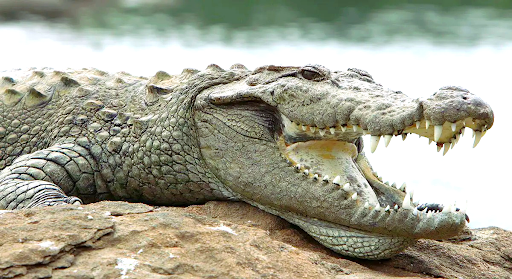It is not strange that this iconic reptile is venerated by Goa’s ethnic community residing in hamlets along the Cumbarjua canal

This is the season of intense precipitation and unprecedented inundation. The water bodies have been filled to the brim and the aquatic spillover is damaging life and property. The deluge is catastrophic and energy that this runoff holds can uproot gigantic trees, shake foundations of engineered structures, and even sweep away and drown humans as is being reported from different parts of the country.
The rain stirred turbulence in the water body is a disturbance to the life within and often the species that reside in the water tend to get washed off and stranded in drier places. This ‘fish out of water’ situation occurs literally if the rains continue pouring for more than a couple of days as happened recently in Goa. But then our water bodies do not hold only 'kullyo', 'thigur' and 'kongge', but a diverse range of aquatic and amphibious life.
Goa’s charismatic yet ignored reptile, the mugger for instance has been residing in the estuarine and fresh waters here even before the Portuguese conquest, according to João de Barros the Portuguese chronicler. This reptile has played a pivotal role in securing the aquatic boundaries of pre-Portuguese Goa, by deterring enemies seeking to conquer our land by invasion through the sea! It is not strange that this iconic reptile is venerated by Goa’s ethnic community residing in the hamlets along the Cumbarjua canal, a significant abode of mugger in Goa.
It is a cruel paradox that this ‘protector’ that once guarded our territory today needs protection from malicious mischief of the ignorant humans who share its habitat. The mugger must be redeemed from the apathy of the state wildlife authorities who’ve chronically underplayed its ethical, ecological and spiritual values for the state and left it to fend for itself amidst rising cases of human-crocodile conflicts, and worst of all its fast-vanishing habitats. We must remember that articles 48A and 51A of the Indian constitution clearly prescribe responsibilities of the state and people respectively towards protecting our wildlife and improving their habitat.
Recently, a video clip went viral on social media in testimony of the harrowing treatment meted out to a fully grown crocodile in Guirdolim Chandor, a serene Salcete village known for its heritage homes. The terrified and tormented reptile was immobilized with ropes and dragged along the tar road, with scores of excited men and women recording videos of this condemnable act and misadventure that clearly qualifies as a cognizable offence under Indian Wildlife Protection Act, section 9, which forbids and recommends punitive action for disturbing, capturing and injuring scheduled wildlife. Mugger is a schedule-I species by law, and a flagship species of Goa’s mangrove forests, that renders yeoman’s service to fisherfolks by sanitizing our waters of oxygen-depleting organic wastes.
For a state struggling to find exciting and environment-friendly alternatives to their overburdened seashore-based tourism, crocodile safaris are a ‘top grab’ by conscientious tourists. For some strange reasons our forest department chooses to ignore the mugger, relegating it to a ‘conflict species’. Rescuing stray muggers alone cannot save this important wildlife, there must be a concerted attempt to project it as our pride and responsibility.
Considering its historical cultural and ecological significance to Goa, the least I think that the state wildlife board can do for this languishing reptile is to prop it up by giving it the status of our ‘state reptile’. A more ideal scenario would be to declare at least some stretch of the Cumbarjua canal as ‘Crocodile Park’ after careful assessment of implications for those dependent on the canal for livelihood.
The image of mugger may be included preferentially in some official insignia of entities related to wildlife conservation in the state, to elevate this reptile in the public eye. There must be appropriate publicity given to this reptile and its habitats throughout the state through signboards and hoardings erected in strategic places such as mangroves, ponds, lakes; highlighting its legally protected status, conservation value, safety measures to avert a conflict, and most importantly punitive provisions to prosecute violators.
The rescue squads in the wildlife divisions of north and south Goa must be upgraded for efficient rescue operations at short notice, to minimize stress to muggers in acts of hooliganism. As an educator it pains me to note that our Boards of studies at school level have not given necessary coverage to this ignored reptile in curriculum, which could have been an effective way to evoke empathy and appreciation for the reptile in formative years.
One of the core concerns of our times is the heightened human-wildlife conflict resulting in loss of life and property and ever-augmenting hostility towards wildlife. Wildlife managers should attempt to identify and blunt this conflict interface, while ensuring that conservation ethos of the community is not forsaken. Shrinking forests, expanding agro-fields, burgeoning industrial estates and capaciously proliferating urban spaces are all drivers of deterioration and a death knell for wildlife.
That our collective community ethos shapes our attitude towards wildlife and lowers our antagonism despite losses suffered; was best demonstrated by the conduct of our people who shared their living spaces with wildlife. Our ethnic communities through their folk-religious expressions aid in blurring of our shared boundaries with wildlife.
Some of our pagan celebrations in Goa and Gujarat, totemise and sanctify the wild; the mugger crocodile being one such species common to both the states. The Chodhri, Gamit and Vasava tribes of Gujarat and the Hindu Gawdas of Goa are celebrants of crocodile divinity; the Mogra Dev and Mannge Thapnee respectively! These seemingly primitive folk religious expressions are replete with conservation ethos and instil in the folk-psyche a sense of kinship and denizenship within the shared space.